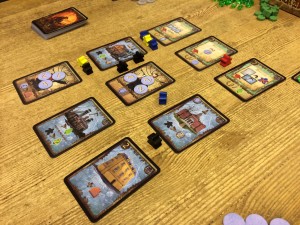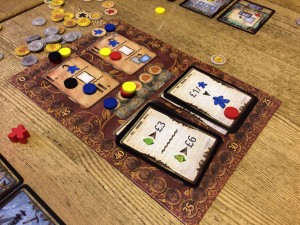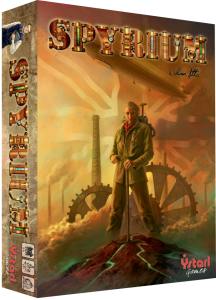Review: Spyrium
Posted by James (admin) on January 23rd, 2014
 Spyrium is a eurogame with an interesting worker placement game mechanic. It is designed by the creator of Caylus and Caylus Magna Carta (the latter being one of my favourite games) so I was keen to try it out.
Spyrium is a eurogame with an interesting worker placement game mechanic. It is designed by the creator of Caylus and Caylus Magna Carta (the latter being one of my favourite games) so I was keen to try it out.
THE GAME
The game has a steampunk-ish setting and players are each head of an industrial conglomerate in Victorian England and spyrium is a mineral high in energy. The player who scores the most victory points (VPs) by the end of the game wins.
Each round 9 cards are drawn from the deck and laid out in a 3×3 grid – I’ll call this ‘the grid’ from now on. Players take turns either placing a worker or activating a worker; however, once a player starts activating their workers, they can’t return to placing workers during the current round. As a result, you have to choose carefully when to switch from placing to activating.
The cards in the 3×3 grid are either characters (one-off benefits that all players can use), buildings (which can be bought to give special actions), and patented techniques (which can be bought to give on-going abilities plus they score VPs at the end of the game too). When a building or technique is bought, it is removed from the grid and placed in front of its owner.
Spyrium uses a clever worker placement system because workers are placed between the cards on the grid. When a worker on the grid is activated, it can use either one of the two cards that the worker is positioned between (assuming no-one buys/removes one of the cards beforehand). After it is activated, the worker is removed from the grid.
You can activate a worker to buy a building card, buy a technique card or use a character card’s ability. However, any of these activations costs money equal to the card’s cost plus the number of other workers (of any player) that are positioned next to that building. Alternatively, a worker on the grid can be activated to earn cash equal to the number of other workers (of all players) currently surrounding one of the cards next to the activated worker.
Each round, you can use buildings you have bought for their effects and some buildings allow you to use workers that you didn’t place on the grid to give better effects. Plus, there is a special event each round which all players can use. After 6 rounds, the game ends and players score VPs for buildings they built as well as technique cards (which score VPs based on things like amount of cash remaining).

This is the game board which tracks if players are placing or activating workers, shows their income, and the current and next rounds’ event cards.
THOUGHTS
Spyrium is an economic engine game which, whilst simple, really does offer lots of tricky choices and interesting decisions. Where to place your workers is an interesting decision. You want to place your workers so (a) you place them between two helpful cards you so that you have options, (b) you increase the cost of cards for other players, and (c) you don’t broadcast your intentions too much to other players. However, the cost of using/buying a card can change during the round too as players place and remove their workers. So, the order in which workers are added and removed also makes a difference to you and your opponents.
In addition, you also have to decide when to stop placing workers (you may not want to place them all on the grid so you can use them on your buildings). Sometimes you have to stop placing so you can activate a worker to buy a card before someone else does (or earn more cash before workers are removed). This is a fun and tricky choice; plus, there’s a bit of a push-your-luck element too: Do you stop placing and activate a worker now in case opponents place workers making it too expensive? Do you wait for other players to remove workers to make it cheaper hoping no-one else buys it before you?
(The rising cost based on the number of nearby workers reminds me a little bit of Die Speicherstadt – which is a good thing – where the more workers queued at a card increase the cost. However, there is less prescribed order in Spyrium which makes it feel very different.)
Cash feels like it is in short supply – you get a small income per round (which you can increase with special buildings) so gaining cash through removing workers is important. As a result, workers feel like they’re in short supply too (especially when you have buildings that require them). Some buildings can increase your number of workers and income, but these one-off effects are at the expense of having other buildings that can be used each round, so buildings feel like they are in short supply too.

Buying buildings and techniques that work well together is very important so that you have a good production engine. For example, I was pleased to have two buildings that generated 5 spyrium a round (and a technique which meant I didn’t need to use any workers for that) and a building that converted 5 spyrium into 15 VPs by using 2 workers on it.
The grid cards are divided into 3 periods so the cards get increasingly powerful as the game progresses. I’ll be interested to see how/if players change their tactics over repeat plays. I think much of the difference in tactical choices in games will come from the mixture of grid and event cards (and the costs/benefits of some cards) as these are randomly drawn.The events are varied and can be quite powerful depending upon their timing with your plans. The rules are clear and the iconography on the cards is good too. I felt the theme was fine – the industrial Victorian theme comes through strongly, but the spyrium part could have been dialed-up a bit more; however, this doesn’t have any negative impact so isn’t an issue.
Overall, Spyrium was surprisingly dense in decisions, especially given it’s such a physically small game. A great eurogame for those wanting a bit more than a light euro, as well as a good game for gamers who want a relatively quick but challenging and competitive experience. Very good indeed.
More information and the rules can be found on Ystari’s Spyrium page: bga.me/spyrium
James.
[Played with 4 players]

